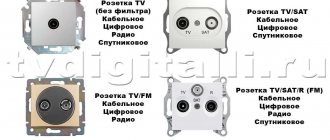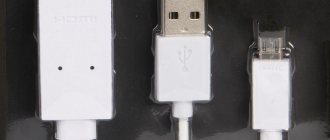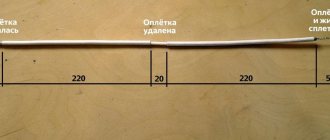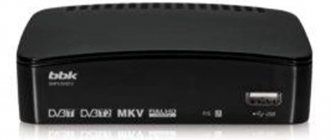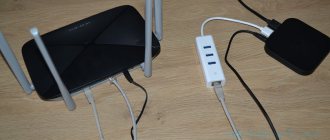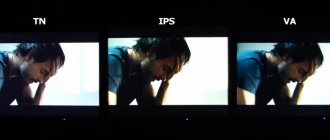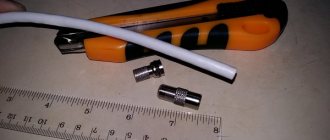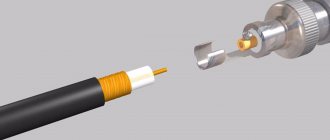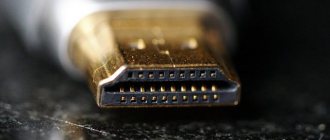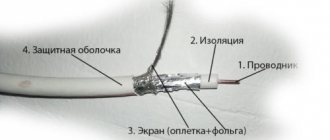To connect the antenna directly to the TV, you only need an antenna cable, which has long been familiar from meter-band receivers (MV, analogue television). Its main task is to transport the signal from the antenna and display the image on the TV. At the same time, all antenna wires have a significant drawback - reduced signal quality. For this reason, you need to responsibly approach the question of how to choose an antenna cable. But before that, you need to know its properties, which are described in this article.
How does a television cable work?
The antenna cable is very different from the usual network wires in that it has a more complex structure and each component must be considered separately. Wires of this structure are called coaxial cables.
Lived
A central wire that resembles a core when cut crosswise. The composition is made of copper or alloys. The first option is preferable for safety reasons - copper is more susceptible to heating and has a high level of thermal conductivity. Consequently, if there is a short circuit or overcurrent is applied to the cable, rapid heating and an increase in resistance will occur, to which the TV fuse will immediately react. Steel alloys in this case will be less effective.
It is also advisable to choose a thicker core (~1 mm), because As the diameter increases, the attenuation coefficient decreases.
Screen
An outer conductor that prevents the signal from being attenuated by propagating outside the cable. Its functions are comparable to that of a satellite dish reflector. Today there are three screen options - foil, aluminum film and wire braid. The latter option for making a screen is less expensive and such cables are the cheapest. However, the outer wire is not solid, which greatly increases the attenuation coefficient. It is possible to use such a cable for digital television only when using an indoor antenna. Significant signal loss is guaranteed when the distance from the receiver to the TV is more than 1 m.
Foil and film are solid screens that reduce the attenuation coefficient to zero. This cable is recommended for connecting terrestrial and satellite television with an outdoor antenna. Foil would be preferable, but remember that it is not flexible and will break if bent too hard. If you choose to install an antenna on the roof of an apartment building, you need a long cable for wiring to the apartment and strong bends are planned, you will have to buy a cable for the most expensive TV, the screen of which consists of foil with a surface braid. In this case, it is used to protect the screen from damage at the bend points.
Shell
Insulating material made from HDPE or PVC. It can be white or black, less often gray. You can choose a cable for TV without being particularly interested in the casing, because... it does not affect the system characteristics of the cable. It is recommended to consider a denser material (since it is less susceptible to wear and heat), but within reasonable limits, because as it increases, flexibility decreases.
Plug
There are two types of plugs on the market: in a single design and in the format of a screw with a nut. In the latter case, it is enough to expose the cable and insert it inside the plug, then tighten it. This method is perfect for those who are not electrically versed and want to quickly connect the antenna wire. If you have the skills to use a soldering iron, it is safer to purchase a plug in a single design and solder the wires.
Design of connecting elements
Structurally, a coaxial antenna cable for a TV is designed on the same principle as other types of cable products.
The cable consists of the following functional parts:
- central core, which is intended for signal transmission;
- dielectric made of polyethylene or fluoroplastic, which ensures insulation of the internal core and its immobility;
- aluminum foil and braiding applied on top of the dielectric layer serves as both a conductor and protection against interference;
- The outer shell of the coaxial cable is designed to protect against exposure to precipitation and sunlight.
Coaxial cable for a TV has a round cross-section, with a diameter of four to eight millimeters.
Cables for satellite and terrestrial digital TV
The digital signal is transmitted in the decimeter wavelength range (UHF), which corresponds to frequencies of 0.3 - 1 GHz (terrestrial TV) and 1 - 3 GHz (satellite TV). The physical characteristics of this signal are very different from those of analog television in the meter (VHF) range - the wave projected onto the receiver has a smaller thickness in diameter. Also, the frequency of arrival (not to be confused with the frequency) of such a signal is higher, so a thicker cable is required.
The optimal characteristics of the antenna cable will be:
- core thickness 0.3 - 1 mm;
- cross-sectional thickness from 3.5 mm;
- resistance 65 - 75 Ohms.
For satellite television, it is recommended to consider higher values, because With them, the signal of channels broadcasting at high frequencies (from 1 GHz) is better preserved.
Marking
When you buy a domestic product, there are usually no difficulties with its designation.
- RK – radio frequency cable;
- 75 – conductor resistance 75 Ohm;
- 4.8 – diameter;
- 34 – the first digit shows the insulation group, heat resistance category. The second digit is the serial number of the development;
- TU – technical manufacturing conditions.
But the labeling of imported cables can be confusing. Meanwhile, here is the definition of Western standards:
- DELINK – manufacturer;
- SAT-752 – name;
- Cu/Cu – material of the central conductor and braid (Cuprum – copper);
- 1.13 – thickness of the central core;
- 0.12*64 – thickness and density of the braid;
- Cu-foil – full copper;
- Coaxial cable – coaxial cable;
- 75 OHM – conductor resistance 75 Ohm;
- ISO 9001-2000 – certificate of conformity.
TV cable
When the cable to the TV is connected directly from the receiver and selecting it is not difficult. But older models do not have a TV tuner (decoder) and to watch digital television you will need to connect a digital receiver. You also need to select the television cable needed to connect the set-top box to the TV.
Modern receivers have a large selection of connectors of different formats, hence a wide selection of television cables. Each of them has a common characteristic by which you should choose a connection method - bandwidth, which determines the data transfer rate. It determines what maximum clarity the image can be transmitted by the wire from the receiver after decoding the digital signal into its usual form. But this is the only parameter that unites all the wires; otherwise they are completely different.
Amplifiers
To amplify the television signal, special devices are used - amplifiers. The device should be close to the TV or antenna. Most often, amplifiers are used to compensate for signal loss due to the use of crabs.
Connecting the TV to the antenna via a video amplifier:
As you can see, choosing and installing a good television wire for an antenna requires taking into account many nuances. But it’s worth it, because with the right choice of TV cable, broadcasting will proceed without interference. We hope that the article on television cables will help you make the right choice.
Types of television wires
If there is only one antenna cable, then there are many types of television wires. Each of them differs in the way they display information and in appearance.
Attention! Do not confuse the antenna and television wires. The first ones are used to receive a digital signal, while the others are needed to display images and sound on the TV in the usual form.
Coaxial
The most common type of antenna cables, which were already discussed at the beginning of the article. One has only to add that coaxial cables include not only antenna cables, but also any electrical wires that in their architecture include a central core (there may be several of them), a screen (external conductor) and insulating material. Coaxial cable is more common not only for terrestrial TV, but is also used by providers to organize a cable TV network.
Composite
This type includes any cable that has more than one connector. The name reflects the multi-tasking nature of the wire, i.e. transmission of several signal formats at once. In the case of television, this is a separate output of image and sound to the TV after decoding. Typical representatives of composite wire are RCA and AV cables for TV. They are also used to connect a video player, speakers and other audio-video devices to a receiver or TV.
Component
Externally, such wires are similar to composite cables, but their operating principles are very different. All present inputs output an image, and only one of them transmits an audio signal along with the video. Component cables have higher bandwidth compared to their composite counterparts. They are not intended to be connected with separate video and audio outputs, i.e. are not compatible with digital TV and are used to watch multimedia from a storage device or interactive television.
HDMI | DVI
With the development of wide-screen digital television, broadcasting in 4K format (~4000p) became available. Despite pre-compression to digital, broadcasting ultra-high definition images requires transmitting a large amount of information. The previously existing wires did not have sufficient bandwidth, so a new cable was developed - hdmi. If the TV and receiver have a connector for this type of television cable, the TV devices support high-definition image output and it is recommended to connect them using an HDMI cable.
Modern Smart TVs and receivers are comparable in capabilities to a computer and have a powerful video adapter of 1 GB or more. Although they also have an HDMI connector, to support video games and other graphics applications, you need to connect from a video card that has a VGA connector. A DVI cable is used for this.
Which cable is better to use to connect the set-top box, it is better to focus on the maximum pixel resolution of the TV, because When connecting wires with a higher bandwidth, it will not increase the clarity of the broadcast, but will increase the power consumption of the receiver.
Connecting multiple TVs
To connect several devices to one antenna at once, splitters are used, which are otherwise called “crabs”.
How to connect multiple TVs to one antenna via a video splitter:
Crabs are recommended for use in areas with strong television signals, i.e. close to television towers, since when a crab is connected, the signal strength decreases sharply. For example, if you connect 2 TVs to one antenna, the signal loss will be about 30%. The number of outputs on the crab must strictly equal the number of connected devices. If there is a free exit on the crab, the signal quality will still drop.
Brands and characteristics
All television cables have a single architecture for each, because... it must be strictly followed to ensure a specific output format. Antenna wires, on the contrary, come in a wide variety.
Their difference is in physical characteristics that determine the mode and service life:
- RG-6U. A universal brand of cable in terms of price/quality ratio. It has a copper core and good double insulation, which gives maximum bending possibilities and a low attenuation coefficient. This wire has a significant drawback - a mediocre level of wear due to the manufacture of the sheath from low-density polyethylene. The RG-6U cable will be the most successful choice for laying indoors under an indoor antenna.
- SAT-50. The most popular brand of antenna cable in Russia. The core is made of copper, and the screen is made of aluminum film with copper braiding. The insulation is made of high-density plastic, resulting in a service life of 15 years. The SAT-50 TV cable perfectly receives signals from the repeater and satellite thanks to the central core with a diameter of 1 mm.
- DG-113. Brand of the most expensive antenna cable. The core and insulating material have characteristics similar to SAT-50. The difference between this cable is an improved screen with a signal amplification factor of up to 90 dB. Such a cable is needed in cases where there is a long distance from the antenna to the TV (for example, when installing on the roof of an apartment building). When laying up to 40 m, interference and image distortion are not observed.
- SAT-703. An analogue of the SAT-50 brand cable, designed for operation in harsh climatic conditions. Its peculiarity is a core made of steel alloys, which heats up more slowly and is more resistant to temperature changes. The cost of the SAT-703 is also comparable to the SAT-50. At the same time, it is better not to buy such a wire for a room, because... this will be an extra expense.
Installation and operation
The antenna wire for the TV, according to its characteristics, is quite resistant to external factors. In this case, it is necessary to follow a number of recommendations for its installation and operation in order to ensure safe use and service life:
- The insulation material must be resistant to current climatic conditions. If there are temperature changes outside, choose a wire for the antenna with a steel core, because its thermal conductivity is lower. In the room, on the contrary, it is better to use a copper core. In this case, the only heating factor can only be a short circuit, to which the wire will react sharply and the TV fuse will trip. This point is extremely important, because As it heats up, the resistance also increases. It reduces the speed at which the signal moves, and it attenuates more before it reaches the decoder.
- Distance between receiver and device. Due to the scattering of the signal from the core, it weakens during transportation. Even the densest double screens with film and braid allow a low attenuation coefficient. Therefore, you need to try to minimize the distance from the antenna to the decoder. If this is not possible, you will need to connect an antenna amplifier. In this case, the power consumption of the receiver will increase.
- Connection method. Modern receivers provide fasteners and clamps for easier wire connection. Despite their presence, soldering remains the most reliable method. Without it, the signal level drops significantly when moving from the receiver to the cable.
Cable bending problems
The practice of cable bending always remains the most difficult moment during operation.
The reason for this is two mutually exclusive factors:
- With any bending there is a significant loss of signal level. It can only be compensated by direct reflection from the screen onto the core, which is only possible when bending at a right angle.
- Over time, the absorption of the cable increases and it becomes looser. Consequently, when bending at a right angle at this point, after just a year the risk of screen destruction greatly increases.
For this reason, it is difficult to find a balance between bending and long service life. It is recommended to avoid bends if possible. Wherever possible, smooth changes in cable direction should be considered within acceptable elasticity limits.
Attention! You should not experiment with cutting the cable and then soldering it or connecting it using adapters and extensions at bend points.
No connection method is capable of maintaining the same signal level when passing through it, which is provided when transporting along an entire cable. Although cutting a coaxial cable eliminates the destruction of the screen in the future, the signal will decrease significantly even at the stage of moving along the wire. To verify this, you can check the difference in the recorded signal level in different cases.
Crimp connection
A screw connection is made without the use of a special tool, but a connection with a crimp connector is considered better. The tight contact obtained during crimping ensures more reliable signal reception. If you have a special tool, the question of how to crimp a coaxial cable for a TV can be solved very simply.
Crimp connection technology:
- Place the crimp ring on the cable and trim the insulation 6mm from the edge.
- Expose the inner conductor, being careful not to damage it.
- Insert the center conductor into the connector, and then slide the crimp ring onto the connector pad.
- Using special crimping pliers, clamp the ring so that the transmitting core is pressed tightly against the connector contact.
- Remove any excess conductor protruding from the connector.
